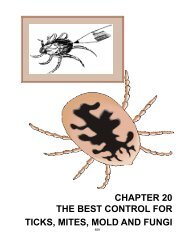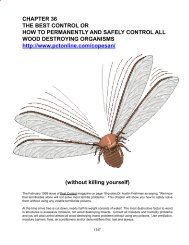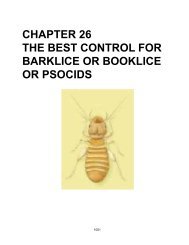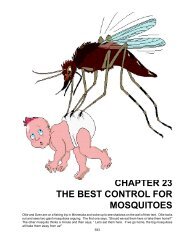chapter 16 the best control for human lice and scabies
chapter 16 the best control for human lice and scabies
chapter 16 the best control for human lice and scabies
Create successful ePaper yourself
Turn your PDF publications into a flip-book with our unique Google optimized e-Paper software.
ORDER ANOPLURA<br />
FAMILY PEDICULIDAE<br />
Three Types of Human Lice<br />
Are you having a lousy time?<br />
The head louse (Pediculus <strong>human</strong>us capitas) (DeGeer), <strong>the</strong> body louse (Pediculus <strong>human</strong>us <strong>human</strong>us) (Linnaeus)<br />
<strong>and</strong> <strong>the</strong> crab louse (Pthirus pubis) (Linnaeus) all occur on <strong>human</strong>s. All three cause considerable skin<br />
irritation as <strong>the</strong>y feed on <strong>human</strong> blood or crawl on <strong>the</strong> body. Typhus, impetigo, trench fever <strong>and</strong> relapsing fever<br />
have all been transmitted by body <strong>and</strong> head <strong>lice</strong>. Scratching can lead to secondary bacterial infections leaving<br />
children feeling achy, feverish <strong>and</strong>/or lethargic. Human <strong>lice</strong> can establish <strong>and</strong> maintain <strong>the</strong>mselves only on <strong>human</strong>s.<br />
A louse cannot hop or jump. They can, however, crawl fast. They are usually transmitted only through<br />
close personal contact. They are less frequently transmitted through <strong>the</strong> sharing of personal articles or toilet<br />
seats. For head <strong>lice</strong>, this includes combs, brushes <strong>and</strong> o<strong>the</strong>r grooming aids, hats, headb<strong>and</strong>s, helmets, caps,<br />
headrests, wigs, curlers or o<strong>the</strong>r headgear, especially when <strong>the</strong>se items are stored in shared lockers. They<br />
spread or infest by crawling, <strong>the</strong>y live by biting <strong>and</strong> sucking blood from <strong>the</strong> scalp <strong>and</strong> can survive <strong>for</strong> up to 48<br />
hours off a <strong>human</strong> head, <strong>and</strong> <strong>the</strong> nits on a hair shaft can survive from 4 - 10 days - so vacuum thoroughly <strong>and</strong>/<br />
or spray/clean with diluted enzyme cleaners or peppermint soaps. Head <strong>lice</strong> infestations have been a problem<br />
a long time - Pliny, a Greek naturalist (23-79 AD) suggested bathing in viper broth. Montezuma paid people to<br />
pick nits off his subjects, dried <strong>the</strong>m <strong>and</strong> <strong>the</strong>n saved <strong>the</strong>m in his treasury. W. Coles in his <strong>16</strong>57 book Adam in<br />
Eden: or Nature’s Paradise noted that <strong>the</strong> oil from hyssop (Hyssopus) “killeth <strong>lice</strong>.” Nicholas Culpeper in his<br />
<strong>16</strong>81 The English Physician Enlarged recommended tobacco juice to kill <strong>lice</strong> on children’s heads, a very early<br />
reference to <strong>the</strong> use of tobacco as an insecticide poison. Medical historians trace head <strong>lice</strong> infestations back<br />
9,000 years! In <strong>the</strong> U. S. head <strong>lice</strong> are not “known” to spread disease or cause serious injury - <strong>the</strong>y are only<br />
considered to be “repugnant”. Like o<strong>the</strong>r U. S. public health agencies, <strong>the</strong> National Center <strong>for</strong> Disease Control<br />
<strong>and</strong> Prevention have never tracked head <strong>lice</strong> outbreaks, said official, Tom Skinner. Sometimes called “mechanized<br />
d<strong>and</strong>ruff.” Head <strong>lice</strong> may be nasty, itchy <strong>and</strong> very contagious, but <strong>the</strong> poisons sold to get rid of <strong>lice</strong><br />
are even worse. Among <strong>the</strong> reactions to poison shampoo or <strong>lice</strong> “treatments” are seizures, mental retardation,<br />
many different allergies <strong>and</strong> respiratory problems, strange tingling, burning, itching, attention deficit disorders,<br />
brain tumors, leukemia, cancer <strong>and</strong> death. The Author does not suggest <strong>the</strong> use of poisons to <strong>control</strong> <strong>lice</strong>.<br />
788









